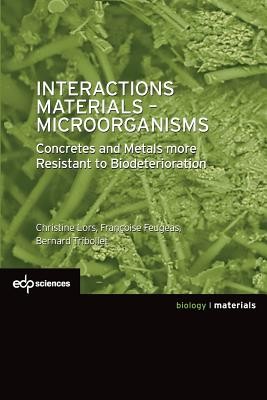
- We will send in 10–14 business days.
- Publisher: EDP SCIENCES
- ISBN-10: 2759822001
- ISBN-13: 9782759822003
- Format: 15.6 x 23.4 x 2.9 cm, minkšti viršeliai
- Language: English
- SAVE -10% with code: EXTRA
Interactions Materials - Microorganisms (e-book) (used book) | bookbook.eu
Reviews
Description
This multidisciplinary book is the result of a collective work synthesizing presentations made by various specialists during the CNRS «BIODEMAT» school, which took place in October 2014 in La Rochelle (France). It is designed for readers of a range of scientific specialties (chemistry, biology, physics, etc.) and examines various industrial problems (e.g., water, sewerage and maintaining building materials).
Metallic, cementitious, polymeric and composite materials age depending on their service and operational environments. In such cases, the presence of microorganisms can lead to biodeterioration. However, microorganisms can also help protect structures, provided their immense possibilities are mastered and put to good use.
This book is divided into five themes related to biocolonization, material biodeterioration, and potential improvements to such materials resulting in better performance levels with respect to biodeterioration:
- physical chemistry of surfaces;
- biofilm implication in biodeterioration;
- biocorrosion of metallic materials;
- biodeterioration of non-metallic materials;
- design and modification of materials.
The affiliations of the authors of the various chapters illustrate the synergy between academic research and its transfer to industry. This demonstrates the essential interaction between the various actors in this complex field: analysing, understanding, and responding to the scientific issues related to biodeterioration.
EXTRA 10 % discount with code: EXTRA
The promotion ends in 22d.11:31:14
The discount code is valid when purchasing from 10 €. Discounts do not stack.
- Publisher: EDP SCIENCES
- ISBN-10: 2759822001
- ISBN-13: 9782759822003
- Format: 15.6 x 23.4 x 2.9 cm, minkšti viršeliai
- Language: English English
This multidisciplinary book is the result of a collective work synthesizing presentations made by various specialists during the CNRS «BIODEMAT» school, which took place in October 2014 in La Rochelle (France). It is designed for readers of a range of scientific specialties (chemistry, biology, physics, etc.) and examines various industrial problems (e.g., water, sewerage and maintaining building materials).
Metallic, cementitious, polymeric and composite materials age depending on their service and operational environments. In such cases, the presence of microorganisms can lead to biodeterioration. However, microorganisms can also help protect structures, provided their immense possibilities are mastered and put to good use.
This book is divided into five themes related to biocolonization, material biodeterioration, and potential improvements to such materials resulting in better performance levels with respect to biodeterioration:
- physical chemistry of surfaces;
- biofilm implication in biodeterioration;
- biocorrosion of metallic materials;
- biodeterioration of non-metallic materials;
- design and modification of materials.
The affiliations of the authors of the various chapters illustrate the synergy between academic research and its transfer to industry. This demonstrates the essential interaction between the various actors in this complex field: analysing, understanding, and responding to the scientific issues related to biodeterioration.


Reviews